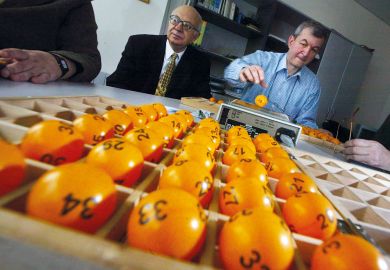Scientific strategy is regarded by some researchers as a rather disreputable concept, redolent of superficial fad-chasing. But, for research funders, astute allocation of resources can help to jump-start emerging fields.
For this reason, it makes sense for government-supported research funding agencies to undertake strategic planning exercises every five years or so. Science does not tend to conform obediently to such predictive exercises, but there is value in at least attempting – as the Canadian Institutes for Health Research (CIHR) is currently doing – to prognosticate the future by surveying trends and ideas that might yield significant rewards if given extra resources.
Fortunately, individual scientists tend not to devise their own strategic plans – and those that do rarely stick to them. Instead, they continually submit their evolving ideas to agencies in the form of grant applications, hoping to convince peer reviewers of their importance. This “scattergun” approach has a robust track record of success as researchers are both quick to react as new information is received and far more imaginative than the collective wisdom of agencies trying to predict future success.
However, organising scientists is like herding cats, and our only consistent behaviour is that we continually change our minds. Hence, “investigator-initiated” programmes, while typically accounting for the lion’s share of both funding and scientific output, are rarely the focus of strategic planning exercises. Because of that, they are in danger of neglect and indirect harm.
This situation is exacerbated by the structure of CIHR, which was cemented at its creation in 2000. Alluding to its far larger neighbour, the US National Institutes of Health, CIHR comprises 13 institutes covering a range of topics, from nutrition and metabolism to ageing, cancer and Indigenous peoples’ health. Unlike the NIHs, CIHR institutes are virtual rather than physical, but they are treated as if they are similarly set in stone, each having a scientific director, a small secretariat and an advisory board.
Each is allocated a budget to invest in funding mechanisms that pertain to its sphere of interest, and there is pressure on each scientific director to deliver specialised funding competitions. However, while these competitions are open to anyone, they are usually, by their nature, narrowly focused. Hence, they support only a handful of successful applicants.
The issue, in case it is not already apparent, is this. Imagine a company whose executive management is judged on its ability to create, with very limited budgets, an endless array of bespoke funding widgets – despite the fact that the company’s primary product is built by a large number of distant workers, over whom it has no control except in setting their portion of the overall budget.
I place no blame for this conflict of interest on current leaders of the agency. They are playing the cards they were dealt and clearly respect the existence of the investigator-initiated programme. Indeed, a few years ago, the collective of scientific directors – known as the Science Council – diverted funds from the strategic pool to the open competition owing to a disastrous foray into virtual reviewing that led to a loss of confidence by applicants and an associated spike in application pressure. However, looking forward, it is increasingly difficult to see the open competition thriving, given the sheer concentration of effort on strategic vehicles.
What might be the solution? Here are a few unsolicited strategic ideas. First, enshrine a fixed proportion of the total agency budget to be dedicated to investigator-initiated funding (excluding capacity-building or anything else other than individual or team grants). This fraction should be immune to political intervention; if government wanted to give the agency C$20 million to tackle an imminent threat of toe fungus, C$20 million would automatically be added to the open competition budget. Failure to do this is how the open budget fraction has been eroded over time.
Another wise move would be to reduce or increase the number of institutes when appropriate, and limit each to a fixed term – with the notable exception of the Institute for Indigenous Health, which has its work cut out for at least a century given the enormous health disparities suffered by Indigenous peoples. A decade should be long enough to make clear an institute’s impact (making its continued existence less necessary) or lack of it (meaning it should be replaced).
It would also make sense to add several active scientists at different career stages to the Science Council to provide independent voices, and to apply the same strictures to strategic as to open competitions – of which the CIHR holds two a year. Applications to strategic competitions could be evaluated by those same open competition panels, chosen for their suitable expertise, but adjudicated using the programme-specific criteria. The different competitions should be subject to similar success rates.
The rigid, hobbled constitution of CIHR should not be the hill that Canadian health science slowly dies upon. After 20 years of existence and at least 10 of budgetary stagnation, this body begs for externally applied defibrillation. Otherwise, it will inevitably turn further inward, in a misguided attempt to micromanage scientific methodology.
Predicting the future is hard. We must restore trust in the diversity of scientific imagination to forge progress.
Jim Woodgett is director of research at the Lunenfeld-Tanenbaum Research Institute, Toronto.
Register to continue
Why register?
- Registration is free and only takes a moment
- Once registered, you can read 3 articles a month
- Sign up for our newsletter
Subscribe
Or subscribe for unlimited access to:
- Unlimited access to news, views, insights & reviews
- Digital editions
- Digital access to THE’s university and college rankings analysis
Already registered or a current subscriber?









